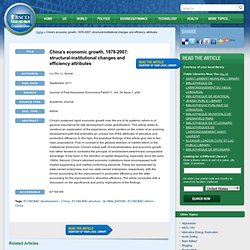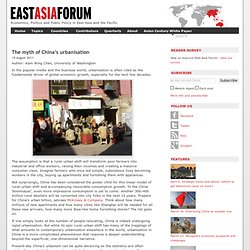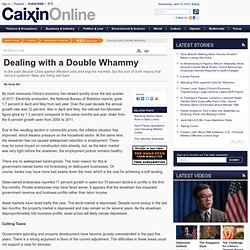

Rebalancing China: China's consumer-led growth. China's economic growth, 1978-2007: structural-institutional changes and efficiency attributes - Tags: ECONOMIC development. Home » China's economic growth, 1978-2007: structural-institutional changes and efficiency attributes Lo, Dic; Li, Guicai Journal of Post Keynesian Economics;Fall2011, Vol. 34 Issue 1, p59 Academic Journal China's sustained rapid economic growth over the era of its systemic reform is of general importance for late development under globalization.

This article seeks to construct an explanation of the experience, which centers on the notion of an evolving development path that embodies an uneasy mix of the attributes of allocative and productive efficiency. Tags: ECONOMIC development -- China; ECONOMIC structure; GLOBALIZATION; ECONOMIC reform -- China New Bottle, Still Old Wine? Debating growth in China. You are here: Home » Economy » Debating growth in China By Michael Pettis Perceptions have certainly changed a lot in the last few months. As recently as three years ago there were so few analysts who were skeptical about the sustainability of Chinese growth that we rarely disagreed among ourselves. Now, however, the group of skeptics has become large enough that there are serious disagreements among us as to what will happen next. One source of disagreement is about whether Beijing can turn around the current growth slowdown. Weak loan demand certainly does seem to be a problem. Times have certainly changed.
In those days Beijing could pretty much set the pace of growth simply by capping the maximum level of loan growth permitted to the banks (actually not so simple because for the past decade Chinese banks have expended all their ingenuity in figuring out how to cheat the loan caps). Nonetheless I am not so sure I agree with them. Why is this important? The myth of China’s urbanisation. Author: Kam Wing Chan, University of Washington In the popular media and the business world, urbanisation is often cited as the fundamental driver of global economic growth, especially for the next few decades.

The assumption is that a rural–urban shift will transform poor farmers into industrial and office workers, raising their incomes and creating a massive consumer class. Imagine farmers who once led simple, subsistence lives becoming workers in the city, buying up apartments and furnishing them with appliances. Not surprisingly, China has been considered the poster child for this linear model of rural–urban shift and accompanying inexorable consumption growth. To the China ‘boomsayer’, even more impressive consumption is yet to come: another 300–400 million rural dwellers will be converted into city folks in the next 15 years.
If one simply looks at the number of people relocating, China is indeed undergoing rapid urbanisation. Dealing with a Double Whammy. In the past decade China gained Western jobs and exports markets, but the loss of both means that serious systemic flaws are being laid bare By most measures China's economy has slowed quickly since the last quarter of 2011.

Electricity production, the National Bureau of Statistics reports, grew 1.7 percent in April and May from last year. Over the past decade the annual growth rate was 12 percent. Also in April and May, the railroad ton-kilometer figure grew by 1.3 percent compared to the same months last year, down from the 6 percent growth seen from 2005 to 2011. Due to the resulting decline in commodity prices, the inflation situation has improved, which lessens pressure on the household sector. Government spending and property development have become grossly overextended in the past five years. A labor shortage, the result of three decades of the "one-child policy,” and rising inefficiency due to the rapid expansion of the state sector make the economy prone to inflation.